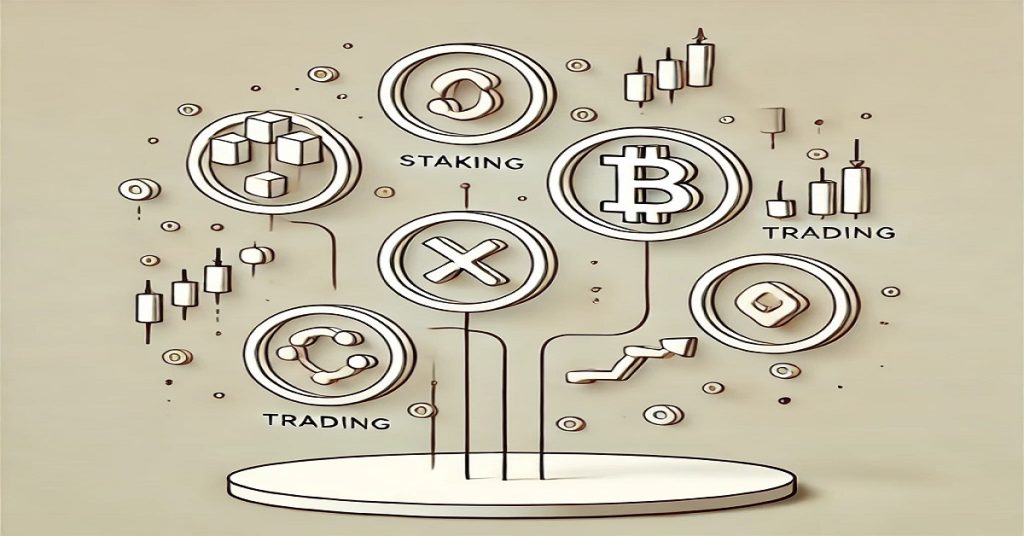Introduction
If you’ve been in the crypto space for a while or even just starting out, you’ve probably heard of crypto staking. But is staking crypto worth it in 2025? The answer depends on your goals, risk tolerance, and the kind of crypto you’re holding.
Staking has grown fast. More investors are looking for ways to earn passive income without trading daily. Still, many wonder if it’s really as rewarding as it sounds. Let’s break it down in simple terms.

What Is Crypto Staking?
Crypto staking is when you lock up your cryptocurrency in a blockchain network to help support its operations, like validating transactions. In return, you earn rewards — usually more of the same coin you’re staking.
Think of it like earning interest on a savings account, but with crypto. But instead of a bank, it’s the blockchain not paying interest but rewarding you .That’s why many investors start by asking, is staking crypto worth it compared to just holding?
How Does It Work?
You choose a crypto that supports staking (like Fortis, Ethereum, Solana, or Cardano), lock it up in a wallet or platform, and let it sit. As time passes, you earn a reward based on how much and how long you stake.
Let’s say you stake 10,000 Fortis tokens. If the daily reward rate is 0.2%, you’re making 20 FTS per day — not bad for doing nothing!
Is Staking Crypto Worth It for Beginners?
For beginners, one of the most common questions is: is staking crypto worth it if you don’t have experience or a large budget? Yes, staking can be a great way for beginners to earn passive income, especially if you’re not into day trading. But like anything in crypto, it comes with risks. Coins can go up or down in price, and if the token loses value, so do your staking rewards.
That said, for many beginners, staking is worth it because:
- It’s simple
- You don’t need special skills
- It encourages long-term holding
What Are the Best Cryptos for Beginners to Stake?
If you’re new, it’s wise to stake coins that are stable, have strong communities, and offer consistent returns.
Need help picking? See this list of best beginner-friendly cryptos for 2025.
Popular options include:
- Fortis (FTS) – Daily rewards and easy to use.
- ADA – Simple staking and low fees.
- SOL – Strong ecosystem and fast transactions.
Pros of Staking Crypto
Here are the main benefits:
- Passive Income
You earn rewards just for holding your coins. - Eco-Friendly (for PoS coins)
Staking supports proof-of-stake networks, which are greener than mining. - Better than HODLing Alone
Instead of letting your coins sit idle, staking makes them work. - Compounding
Some platforms let you restake your rewards, growing your earnings over time.
So, is staking crypto worth it? Many would say yes — especially when you plan to hold long term. Considering these benefits, it’s easy to see why many believe staking crypto is worth it, especially in 2025.
Cons of Staking Crypto
Let’s be real, it’s not all sunshine.
- Lock-in Periods
Some platforms require you to lock your coins for days, weeks, or even months. - Price Fluctuations
If the coin drops in value, your staking rewards might not mean much. - Unstaking Delays
Some tokens have an “unstaking period” which can delay withdrawals. - Smart Contract Risk
If you’re staking through DeFi platforms, bugs in the code can be risky.
So, is staking crypto worth it even with these downsides? That depends on your strategy and risk level.
Real Examples of Crypto Staking Rewards
Let’s look at some real examples (numbers may vary):
- Fortis (FTS) – With a 0.2% daily reward rate, staking 100,000 FTS would earn you around 200 FTS daily. That’s 6,000 FTS per month.
- Ethereum (ETH) – Around 4-5% yearly. Staking 1 ETH (~$3,500) would earn you $140–$175 per year.
- Solana (SOL) – Around 6–7% annually.
- Cardano (ADA) – About 4–6% annually.
Is Staking Crypto Worth It During Bear Markets?
That’s a good question. If the token you’re staking drops in value, your rewards could be worth less. But for long-term holders, staking crypto is still worth it, even during bear markets. You’re accumulating more tokens during the downturn — which could be worth more later.
Is Staking Crypto Worth it on Small Budgets?
Even with a small budget, you can stake. Many platforms don’t require big amounts. It might take longer to see gains, but it builds up over time. Plus, you learn how staking works without risking much.
Yes, and that’s one of the best things about staking. You don’t need thousands of dollars. Even $10–$50 worth of crypto can be staked on many platforms.
Some projects like Fortis even allow flexible staking with no lock-ins. This is ideal for small investors who want to test the waters.
Want to grow slowly but surely? Check out this post on making $1,000 a month with crypto.
Where to Stake Safely?
- Centralized Exchanges (like Binance, KuCoin) – Easy to use, but you trust them with your coins.
- DeFi Platforms (like FortisCrypto.com) – You keep full control, but you need a bit of technical know-how.
- Wallets (like Trust Wallet or MetaMask) – Some support native staking.
No matter which method you choose, security and transparency will help answer the question — is staking crypto worth it for you?
Opinions From the Community
Many crypto users say staking is the easiest way to earn passive income. Others argue it’s not exciting unless you’re staking large amounts. But even if your returns are small, staking builds habit and discipline.
Some Reddit users shared their staking gains:
- “I made $120 in SOL last month doing nothing.”
- “Been staking ADA for 2 years, the price went down but I accumulated more coins.”
How to Start Staking in 3 Easy Steps
- Get a wallet or use an exchange
- Buy a coin that supports staking (like Fortis)
- Stake it and watch rewards grow
And you’re done. Simple as that.
Final Verdict: Is Staking Crypto Worth It?
So… is staking crypto worth it? If you’re a long-term investor looking for passive income and not planning to sell anytime soon, staking is absolutely worth it.
You won’t get rich overnight, but you’ll earn steady rewards — and that adds up.
Whether it’s Fortis, Ethereum, or another token, staking helps you grow your stack while supporting the network. That’s a win-win.
Resources:
ATO – Cryptocurrency and Tax
(From the Australian Taxation Office)
This official page explains how crypto is taxed in Australia, including staking, capital gains, and record-keeping. It’s great to add to your staking page or FAQs to boost trust and authority.
What are the best cryptocurrencies to stake in 2025?
Some popular choices include Fortis (FTS), Ethereum (ETH), Solana (SOL), and Cardano (ADA). The best coin for you depends on reward rates, risk, and your long-term outlook.
Can I lose money while staking crypto?
Yes. While you earn rewards, the value of your staked tokens can drop if the market price falls. There’s also potential risk from hacks, bugs, or staking on unreliable platforms.
Is staking crypto taxed in Australia?
Yes. According to the ATO, staking rewards are considered income and must be reported. Capital gains tax may also apply when you sell the coins.
What’s the difference between staking and mining?
Staking supports proof-of-stake (PoS) blockchains and uses less energy. Mining is used in proof-of-work (PoW) systems and requires expensive hardware and high electricity use.
How often do I receive staking rewards?
It depends on the platform and token. Some pay daily (like Fortis), while others reward weekly or monthly.
Can I stake crypto on mobile apps?
Yes. Apps like Trust Wallet, Binance, and MetaMask (with custom integrations) allow mobile staking for various tokens.
What is compounding in crypto staking?
Compounding is when you restake your earned rewards, increasing the amount you’re staking. Over time, this grows your rewards faster.
Is there a minimum amount required to stake crypto?
Many platforms have no or low minimums. For example, you can stake even a few dollars’ worth of Fortis or ADA on supported wallets or platforms.
Can I unstake my crypto anytime?
Some platforms allow flexible unstaking, but others have a lock-up or unbonding period ranging from a few days to weeks.
Are staking rewards guaranteed?
No. While reward rates are projected, they can change due to network decisions, market volatility, or platform performance.
Is it better to stake on centralized exchanges or DeFi platforms?
Centralized exchanges are easier for beginners, but DeFi platforms like FortisCrypto.com offer more control and transparency — though they require more understanding.
Does staking help the blockchain network?
Yes. Staking helps secure the network and validate transactions. You’re contributing to the health and decentralization of the blockchain.
What happens if the platform I’m staking on gets hacked?
If you’re staking via a centralized exchange, your funds might be at risk. Always use trusted platforms and consider self-custody staking for added safety.
Can I stake multiple cryptocurrencies at once?
Absolutely. You can diversify by staking different tokens across multiple platforms to spread risk and increase potential rewards.
Is staking better than keeping crypto in a regular wallet?
Yes, in most cases. Instead of letting coins sit idle, staking puts them to work and earns you passive rewards — as long as you’re comfortable with the risks.


